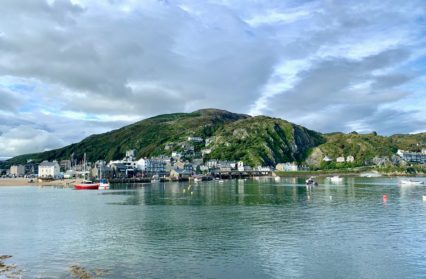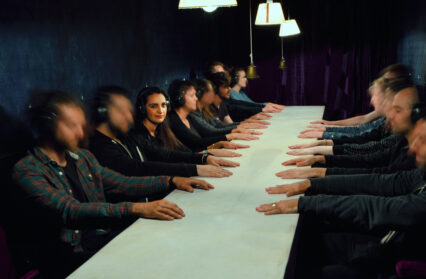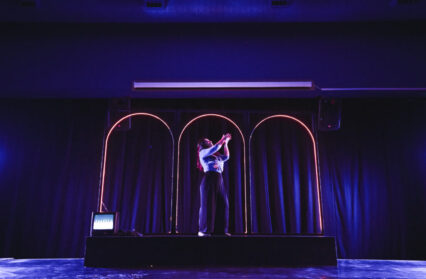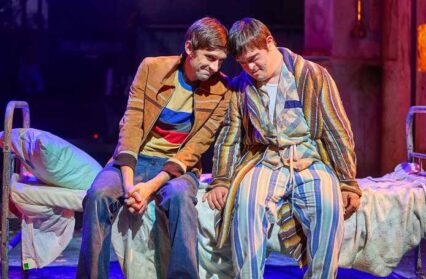Dylan Moore visits Barmouth to witness National Theatre Wales’ latest site-specific production, Marc Rees’ For Mountain, Sand and Sea.
Mark Twain famously said ‘Golf is a good walk spoiled.’ Following the exiled French social reformer Auguste Guyard along a mountain path while he played mandolin and talked about herbs I felt how Twain might have, stuck on the sixth or seventh green, knowing how many holes were to come. The walk around Barmouth – officially the West Midlands’ closest seaside resort – affords panoramic views: the long iron railway bridge stretched long and low across the estuary, the beach below, glorious in midsummer technicolour, high street swarming with tourists in England football shirts, topless men burning like lobsters in beer gardens, tattooed women with pushchairs full of ice-cream faced toddlers. The shrill cries of scrawny twelve year-old barefoot footballers carry on the wind like salt-scent of the Irish Sea. In this show, Barmouth itself is the undoubted star. Vintage railway posters called it the ‘Queen of the Cambrian coast’; curator Marc Rees calls it ‘the perfect place for a site-specific event’. Given the remarkable advantages afforded by the location and the fortuitous weather – one of the hottest days of the year – it is all the more disappointing that Marc Rees’ For Mountain, Sand and Sea failed to deliver, even on its own terms.
The experience begins at a church hall, up a hill in the centre of town, where we are issued with high visibility vests and treated to a cup of Earl Grey and a slice of cake. Director Marc Rees gives an introductory talk, explaining that we will be divided into two groups – pink-badged ‘Candyfloss’ and green-badged ‘Fern’ – to circumnavigate the town in opposite directions. We will be following in the footsteps of Victorian ‘excursionists’, brought here in their hundreds from Manchester via the then new Great Western Railway. We will call at amusement arcades and nightclubs, walk along the beach and up onto the mountainside, loop back to the church hall before a final parade along the high street, finishing up on the bridge. The concept is interesting and workable, but unfortunately, the unexplained opening scene featuring the drunken singing of a French sailor is a sign of things to come. Once we are out with our groups on the excursion itself, corralled by humourless volunteer-guides, all semblance of context is lost and the afternoon becomes like a weak acid trip: a succession of unexplained, disjointed and often poorly executed performances that leave the audience all at sea.
For Mountain, Sand and Sea:
Nightclub
Dingy staircase, walls painted black. ‘Let your eyes adjust to the darkness.’ Bar. Dancefloor. Mirrored walls. Flashing lights. DJ in dark glasses.
Sound of gunfire.
A soldier standing by the fire escape. Finishes cigarette. Walks to centre of dancefloor. Looks at himself in mirrors, multiple reflections. Removes hat, folds neatly. Removes military jacket to reveal vest.
Sound of gunfire.
Thumping dance music. Energetic dancing. More gunfire. Dry ice. Or is it gas? Soldier stands silhouetted against the light and smoke.
Sound of gunfire.
The music changes. Slower now. Glenn Miller, big band. The soldier returns to uniform. An older woman appears. She takes his hand. His mother? They dance slowly, stepping in time.
The DJ packs up, walks off.
We are ushered through the amusement arcade. Flashing lights. Buzzers and bells. Uncomprehending tourists. ‘Let your eyes adjust to the light.’
Beach
Taken to circle of wind breaks. Seated on yellow lilos. Fine, pale sand. Tide out. Sky filled with kites. Roar of motorbikes from beyond the car park.
A woman in a bathing costume dances with a hula-hoop. In the distance, the shrill sound of a whistle. A bearded sailor runs along the beach toward us. Bare chest, hairy. Beige bathers, tight.
Whistle.
He joins the woman in a dance. Blows his whistle repeatedly. Music plays. Dance becomes courtship ritual. Woman jumps on man. Whistle. Woman slides down man. Very sexual. More whistles. End.
We are instructed to lift our lilos and use them to make shapes. Then we make a giant ‘M’, something to do with the monster of the Mawddach.
Mountain
A long climb. Higgledy-piggledy steps. Cottages like hobbit holes. Emerge onto footpath. Bright sunlight, panoramic view.
A man appears up ahead. Fez. Cape. Ridiculous French accent. ‘Je m’appelle Aug-uste Guy-ard… My name? Auguste Guyard. I take herbs. Make soup. You know soup? Soup? Herbs? To make the soup?’ Tells us the Latin names for plants. Plays a song on the mandolin. Eccentric.
Plastic windmills spin in the breeze, sparkly silver with yellow plastic stems; tat from the former chapel pound shops lining Barmouth’s dark stone streets.
A clearing. White sheets draped over gorse bushes, woman in traditional Welsh costume, hat oversized, like something out of Alice in Wonderland. She reads from a book, Grace Darling rowing in a storm. We follow her back down the hill to the church hall as a CD player in her basket makes merry music.
What did he say was in the soup? Mushrooms?
High Street
Outside the draper’s, long-closed shop front.
Enter Marc Rees, resplendent in blue; three-piece suit, silk cravat, fedora. Regales crowd with tales of Tommy Nutter, the Savile Row fashion designer who dressed George Harrison in denim on the cover of Abbey Road and fitted out Mick and Marianne in one of the sixties’ most iconic images.
We are reflected in the shop window. Huddled behind the safety tape, we look like picketing refuse collectors. A gritting lorry rolls by; it is the height of summer. The real council workers laugh.
A young man in a striped beanie ambles past, nonchalantly rolling a cigarette, blissfully unaware of the fact he is on stage at the National Theatre. For once in the afternoon, we excursionists relax, because we understand and appreciate what is going on. Ironically what it proves about this installation is that it is only when real life intrudes that we begin to see real drama.
Promenade:
A song. A prostitute. A man storms off. Bemused onlookers eat their fish and chips.
Corralled into dark shed, shown a film:
Women carrying laundry onto the mountainside, stretching sheets across the coconut-scented gorse. Lingering shots. No dialogue. Women, baskets, sheets, gorse. Ten minutes later there’s a drum beat. Outside. And another. Louder, louder.
Emerge into daylight.
It’s a parading elephant. Rather, two ten year old girls inside papier mache, led by flamboyant beaters of drums. Drum beat, drum beat, colourful elephant. Then it rolls over and dies. Dead elephant.
Bridge
Wartime aircraft pilot sprawled on sand after crash landing. Woman operator with military uniform and clown mask.
J: Request your position, request your position, come in Lancaster . . . come in Lancaster.
P: Position nil, repeat nil, age twenty-seven, twenty-seven. Did you get that? That’s very important. Education interrupted, violently interrupted. Religion? Church of England. Politics? Conservative by nature, Labour by experience. What’s your name?
J: I cannot read you, cannot read you, request your position . . . can you see our signals?
Peter quotes Sir Walter Raleigh and Andrew Marvell. Says he’d rather have written that than flown through Hitler’s legs. June doesn’t understand, requests his position. He doesn’t have a parachute. He’s known dozens of girls, been in love with some of them, but this American girl whom he’s never seen and never shall see will hear his last words.
P: Are you in love with anybody? No, no don’t answer that.
J: I could love a man like you Peter.
P: I love you June, you’re life and I’m leaving you.
He signs off, dies in a sandstorm of interference.
The audience falls silent. Then the pilot rises from the dead to explain that this was a scene from a film: A Matter of Life and Death (1946). For the first time in the whole afternoon, we suspended our disbelief, and the moment was shattered immediately.
Ushered onto the railway bridge, issued with an orange plastic tube and encouraged to whirl it in the air to create our own ‘symphony’. The cast stand at the roadside, send semaphore signals, do their best to look like The Village People.
Handing in my fluorescent orange tabard to a volunteer, I’m filled with a sense of relief that the whole thing – the excursion, the weak acid trip, the good walk spoiled – is over. In return, I am handed a programme in the form of a newspaper. Skim-reading John Sam Jones’ ‘Postcards from Barmouth’ I stumble across explanations for some of the vignettes we have seen: cinemas and dancehalls flourished during the war, French sailors were stranded here after the fall of France and ‘today’s fragranced fabric softeners can’t evoke the clean freshness of the gorse blossom’s heady coconut scent’.
These are things we needed to know, if we were to get anything from the performance at the time. Collected in an oral history ‘story shop’, what we have witnessed here is a potted history of a most interesting town, but Marc Rees’ For Mountain, Sand and Sea, laudably seeking to reinterpret and re-imagine, divorces the stories from roots and context. Strangely memorable and thought-provoking in retrospect, at the time it was simply bemusing.
Dylan Moore has contributed regularly to Wales Arts Review.
For more Wales Arts Review coverage of National Theatre Wales, including news, reviews, and interviews, click here.











